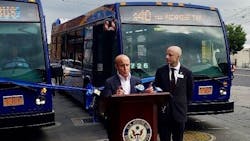New state-of-the-art bus fleet, contactless fare payment system arrives on Staten Island
The Metropolitan Transportation Authority (MTA) and U.S. Rep. Max Rose (D-NY-11) announced that a total of 77 new state-of-the-art buses will be put into service on Staten Island this year as the MTA works to modernize bus service with new vehicles and a new contactless fare payment system that speeds entry and allows all-door boarding.
The new buses are equipped with modern customer amenities such as USB charging ports, Wi-Fi and digital screens and safety technology such as a pedestrian turn warning system and cameras. They replace Orion Hybrid buses from 2009 currently in service on Staten Island, and will be used on routes operating out of the Yukon Bus Depot, which includes S79 Select Bus Service. Additionally, the MTA is in the process of procuring 50 new coach buses that will be put into Staten Island express bus service in 2021.
“Our Staten Island customers are amongst our most vocal and dedicated customers because they rely on our buses far more than riders in other boroughs, which means we absolutely must get bus service right on Staten Island,” said MTA New York City Transit President Andy Byford. “We still have work to do, but the future of public transit is very bright on Staten Island thanks to this new fleet of buses and our myriad work to add new service where possible and enhance existing options.”
“These new buses are just one step towards getting Staten Island the mass transit system we deserve, and I’m proud to be working with the MTA to ensure that this is only the beginning,” said Rep. Rose. “Getting where you need to go on time isn’t too much to ask, and I know that with these new buses on the road, Staten Islanders can expect a more reliable, fast, and comfortable commute. I look forward to these buses getting on the road and showing the people of Staten Island that government can make a difference in their daily lives.”
Of the 77 new buses, which are standard 40-foot-long vehicles used on both local and Select Bus Service routes, 41 have already been delivered. Theses buses will be delivered with software ready for traffic signal priority technology implementation. These capital investments help make MTA more cost efficient, as continuing maintenance to retain older buses well past their useful lives are a significant drain to NYC Transit personnel and funding resources.
As part of similar modernization initiatives, the MTA launched a public pilot on May 31 for OMNY, its new contactless fare payment system, to replace the outdated MetroCard technology by 2023. The public pilot included all Staten Island buses, where hundreds of customers are using their own preferred contactless fare payment method to pay fares and speed their entry onto buses without needing to buy a MetroCard or find exact change. Within the first week of the pilot, Staten Island customers using OMNY have far exceeded initial estimates of 800 to 1,500 taps per week. Both the MTA and Rep. Rose are committed to improving public transportation on Staten Island, from improving existing service to looking at ways to enhance or bring service to underserved areas. In August 2018, MTA New York City Transit implemented a customer-focused redesign of the Staten Island express bus network that has yielded positive results for customers, increasing service reliability, speeding up commutes by up to 12 percent, adding 120 more weekday trips and frequency, and streamlining routes to help clear streets and simplify circuitous routes that unnecessarily lengthened trips. The lessons learned from this redesign will be used for a planned redesign of the Staten Island local bus network, which will take a clean-slate approach to a network that was based on trolley lines from nearly a century ago.
The success of any bus network redesign is largely dependent on close collaboration with stakeholders such as the New York City Department of Transportation and NYPD by providing street treatments and enhancements to help our buses move through congested city streets and to enforce bus lanes and keep streets clear. These enhancements include bus lanes, traffic signal priority for buses, camera enforcement, and reconfigured street traffic infrastructure to increase pedestrian and customer safety.
In addition to improving bus service on Staten Island, the MTA is conducting two studies to bring new service or enhance existing mass transit options on the North Shore and the West Shore. This spring, the MTA launched the West Shore Transit Alternatives Analysis to find new ways to enhance public transit in and to those communities, taking a holistic look at the transportation needs and patterns of West Shore residents. It aims to identify transit improvements and connections between key points on Staten Island and Manhattan, with the goal of making final recommendations in 2020. On the North Shore, the MTA is developing a new Bus Rapid Transit system to provide faster travel for thousands of residents to and from the St. George Ferry Terminal. That project is undergoing an environmental study that will take approximately 24 months.



